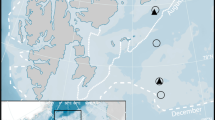Abstract
The sympagic (=ice-associated) amphipod Gammarus wilkitzkii usually lives attached to the underside of Arctic sea ice. During an expedition to the Greenland Sea in May/June 1997, high numbers of this species were found in pelagic Rectangular Midwater Trawl catches (0–500 m water depth) in an ice-free area, 35–42 km away from the ice edge. The amphipods seemed to have maintained position in the water column for at least 4 days. Mean biomass data (length: 2.9 cm, organic content: 73% dry mass), gut fullness (>50% in 85% of specimens) and sex ratio (females:males = 1:1.5) of these amphipods were very similar to values for under-ice populations. Due to their relatively high body density (mean: 1.134 g cm−3), the energy demand for swimming was assumed to be high. Measurements of oxygen consumption of swimming and resting amphipods (8.8 and 4.0 J g wet mass−1 day−1, respectively) suggested that, from an energetic point of view, G. wilkitzkii would maintain position in an ice-free water column for the time period.
Similar content being viewed by others
Author information
Authors and Affiliations
Additional information
Accepted: 11 January 1999
Rights and permissions
About this article
Cite this article
Werner, I., Auel, H., Garrity, C. et al. Pelagic occurrence of the sympagic amphipod Gammarus wilkitzkii in ice-free waters of the Greenland Sea – dead end or part of life-cycle?. Polar Biol 22, 56–60 (1999). https://doi.org/10.1007/s003000050390
Issue Date:
DOI: https://doi.org/10.1007/s003000050390



